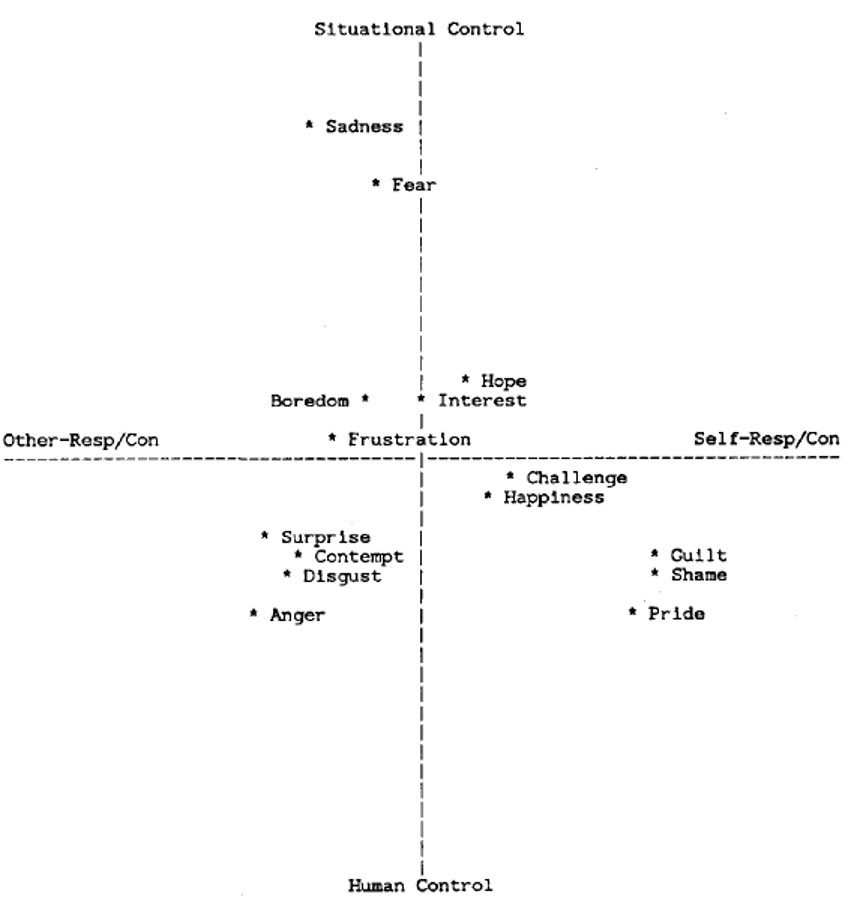Chapter 13: Positive Emotions
Eliciting Events and Cognitive Appraisals
Table 2
Themes Identified in Participants’ Descriptions of 8 Positive Emotions (Campos et al., 2013)
| Positive Emotion | Themes |
|---|---|
| Amusement |
|
| Awe |
|
| Contentment |
|
| Gratitude |
|
| Interest |
|
| Joy |
|
| Love |
|
| Pride |
|
Adapted from “What Is Shared, What Is Different? Core Relational Themes and Expressive Displays of Eight Positive Emotions,” by B. Campos, M.N. Shiota, D. Keltner, G.C. Gonzaga, and J.L. Goetz, 2013, Cognition & Emotion, 27(1), p. 42, 44 (https://doi.org/10.1080/02699931.2012.683852) Copyright 2013 by Taylor & Francis.
In Table 2 above, make note of themes that are unique to each emotion and themes that are present in more than one emotion. For instance, accomplishment is unique to pride, but confidence to take on new challenges in present in both joy and pride. If two themes are present in one emotion, what might this suggest?
Below is a summary of themes that were found in more than one emotion.
- Positive valence was a theme in all 8 positive emotions.
- Except for interest, all emotions mentioned an appreciation for present circumstances suggesting positive emotions occur in environments that are safe, comfortable, and rewarding. Also note, this finding suggests that contentment was not necessarily unique from other emotions.
- Both pride and joy resulted in the theme of confidence to take on new challenges
- Both gratitude and love shared the common themes of vulnerability and commitment, which might suggest they are part of the same emotion family.
Other work (Keltner & Haidt, 2003; Shiota et al., 2007)) suggests that awe is defined by two unique cognitive appraisals. These appraisals are vastness – feeling small in comparison to something larger in one’s environment and accommodation – changing one’s cognitive schemas to account for new information.
More Cognitive Appraisals
In line with eliciting events, cognitive appraisals depend on the emotion that is experienced. For instance, pride is caused by an internal attribution, but awe is caused by an external attribution. (We will discuss cognitive appraisals in more depth later when we discuss Tong’s (2014) study).
In Scherer’s (1997) study, he investigated the cognitive appraisal changes for one positive emotion – joy. For a review of Scherer’s (1997) study, go to the modern theories section on cognitive appraisals.
Means (see Table 3), collapsed across all world regions, show that participants reported the following appraisals when recalling a joy experience: a little expectedness, pleasantness, goal conduciveness, not unfair, external causation: close others; coping: no action required; moral, and an increase self-esteem. In Figure 1, we can see that the cognitive appraisal patterns for joy are universal across all world regions (Note: the presence of a circle around a datapoint indicates that the country with the circle showed means significantly different from the mean of the remainder of the sample; circles are not shown in this figure). Recall that in Scherer (1997) the only emotion to show universality across the eight appraisal dimensions was joy!
Table 3
Mean Changes in Cognitive Appraisal Dimensions for Joy
| Cognitive Appraisal Dimension | Mean | Question | Response Scale |
|---|---|---|---|
| Expectedness / Novelty | 2.07 | Did you expect this situation to occur? | 1 = not at all; 2 = a little; 3 = very much |
| Unpleasantness | 1.02 | Did you find the event itself pleasant or unpleasant? | 1 = pleasant; 2 = neutral; 3 = unpleasant |
| Goal Obstruction | 1.17 | Did the event help or hinder you to follow your plans or achieve your aims? | 1 = it helped; 2 = it didn’t matter;
3 = it hindered. |
| Unfairness | 1.05 | Was the situation unjust or unfair? | 1 = not at all; 2 = a little; 3 = very much |
| External Causation | 2.00 | Who do you think was responsible for the event? | 1 = self/internal;
2 = close persons/external; 3 = other persons/external; 4 = impersonal agency/external |
| Coping Ability | 3.80 | How did you evaluate your ability to act on or to cope with the event and its consequences? | 1 = powerless;
2 = escape possible; 3 = pretend nothing happened; 4 = no action necessary; 5 = could positively influence event and change consequences |
| Immorality | 1.10 | Would this behavior itself be judged as improper or immoral by your acquaintances? | 1 = not at all; 2 = a little; 3 = very much |
| Self-Esteem | 2.90 | How did this event affect your self-esteem? | 1 = negatively; 2 = not at all; 3 = positively |
Adapted from “The Role of Culture in Emotion-Antecedent Appraisal,” by K.R. Scherer, 1997, Journal of Personality and Social Psychology, 73(5), p. 905, 911 (https://doi.org/10.1037/0022-3514.73.5.902). Copyright 1997 by the American Psychological Association.
Figure 1
Eight Cognitive Appraisal Ratings for Joy Across Six World Regions
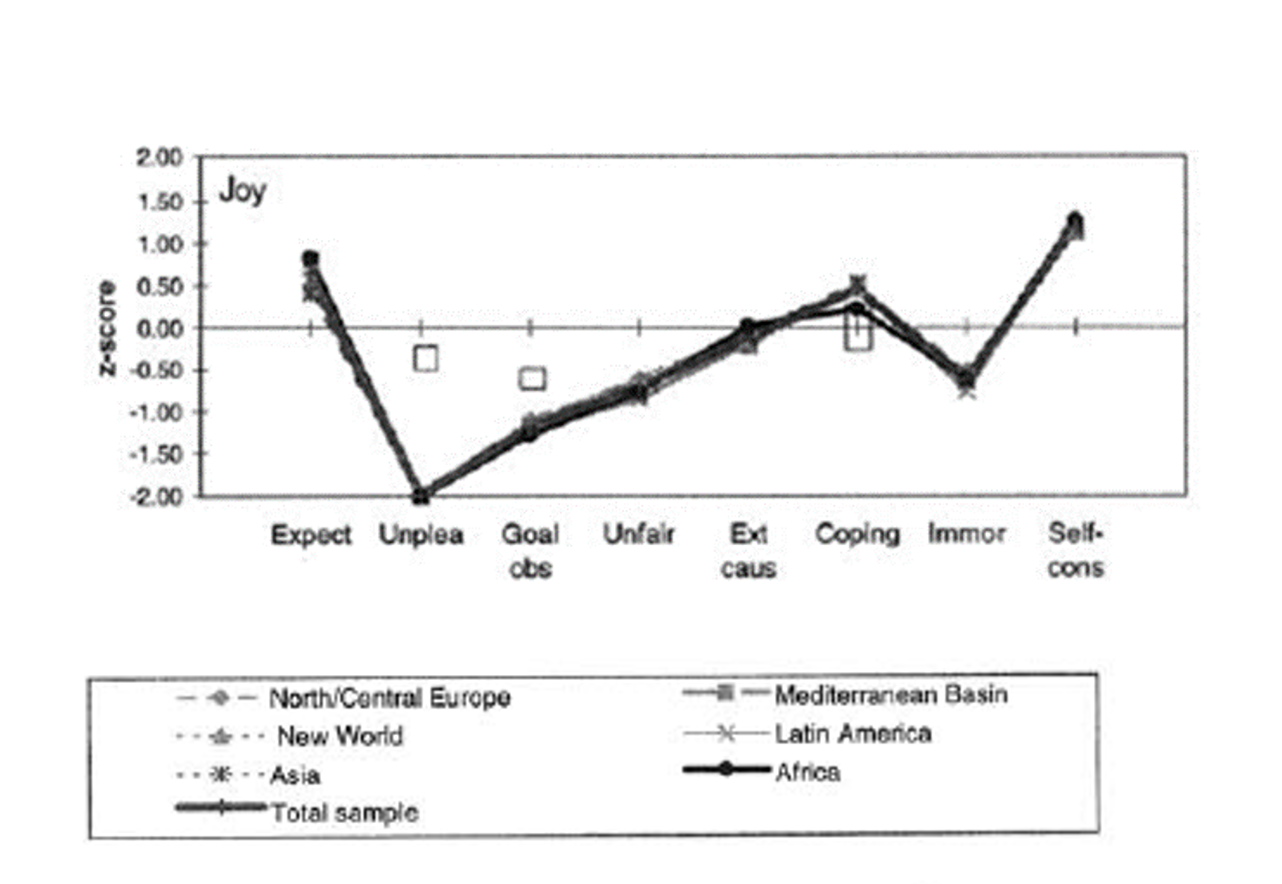
Note. Presence of a circle around a datapoint indicates that the country with the circle showed means significantly different from the mean of the remainder of the sample. Adapted from “The Role of Culture in Emotion-Antecedent Appraisal,” by K.R. Scherer, 1997, Journal of Personality and Social Psychology, 73(5), p. 912, (https://doi.org/10.1037/0022-3514.73.5.902). Copyright 1997 by the American Psychological Association.
In a study by Tong (2014), American and Singaporean undergraduate students recalled and described a personal experience of one randomly selected emotion. Then, participants rated each emotion along the below 13 cognitive appraisals.
| Recalled One Randomly Assigned Emotion |
|---|
| Joy |
| Interest |
| Contentment |
| Gratitude |
| Awe |
| Amusement |
| Pride |
| Hope |
| Romantic Love |
| Challenge |
| Compassion |
| Interest |
| Relief |
| Serenity |
| Rated 12 Cognitive Appraisals |
|---|
| (Un)Pleasantness |
| Relevance |
| Problems |
| Goal Attainment |
| Agency – Self |
| Agency – Others |
| Agency – Circumstances |
| Control – Self |
| Control – Others |
| Control – Circumstances |
| Certainty |
| Predictability |
| Effort |
Table 4
Tong’s (2014) Four Broad Cognitive Appraisal Dimensions
| Broad Cognitive Appraisal Dimension | High scores on cognitive appraisal dimension | Definition |
|---|---|---|
| Achievement | goal attainment, relevance, agency-self, control-self | Important goal achieved by the self |
| External Influence | control-others, agency-others, control-circumstances, agency-circumstances. |
|
| Difficulty | effort, problems, unpleasantness | Problems or obstacles that require effort to overcome and may initially elicit unpleasantness |
| Clarity | certainty, predictability | Good understanding of current situation and/or future events |
Adapted from “Differentiation of 13 positive emotions by appraisals,” E.M.W. Tong, 2014, Cognition and Emotion, 29(3), p. 496 (https://doi.org/10.1080/02699931.2014.922056) Copyright 2014 by Taylor & Francis.
For each cognitive appraisal, select the positive emotion that would cause this specific appraisal and drag it into the corresponding cognitive appraisals drop box. Incorrect answers apply a penalty, and are shown when you submit to check your answers.
Table 5
Cognitive Appraisal Definitions (Tong, 2013)
| Broad Cognitive Appraisal Dimension | High Scores on cognitive appraisal dimension | Definition | High | Low |
|---|---|---|---|---|
| Achievement | goal attainment, relevance, agency-self, control-self | Important goal achieved by self | Pride
Challenge Contentment Joy |
Compassion
Awe Amusement |
| External Influence | control-others, agency-others, control-circumstances, agency-circumstances | Perceptions that events are caused by external forces such as other people or the general situation | Compassion
Hope Gratitude |
Pride |
| Difficulty | effort, problems, unpleasantness | Less pleasant, high effort, problematic experiences | Challenge
Compassion Hope Relief |
Amusement
Serenity Awe Contentment |
| Clarity | Certainty, predictability | Good understanding of current situation and/or future events | Contentment
Pride Amusement Joy Serenity |
Hope |
Adapted from “Differentiation of 13 positive emotions by appraisals,” E.M.W. Tong, 2014, Cognition and Emotion, 29(3), p. 496-497 (https://doi.org/10.1080/02699931.2014.922056) Copyright 2014 by Taylor & Francis.
Figures 2 and 3
Dimensional Mapping of Emotions Based on External Influence and Achievement (Figure 2) and Difficultly and Clarity (Figure 3)
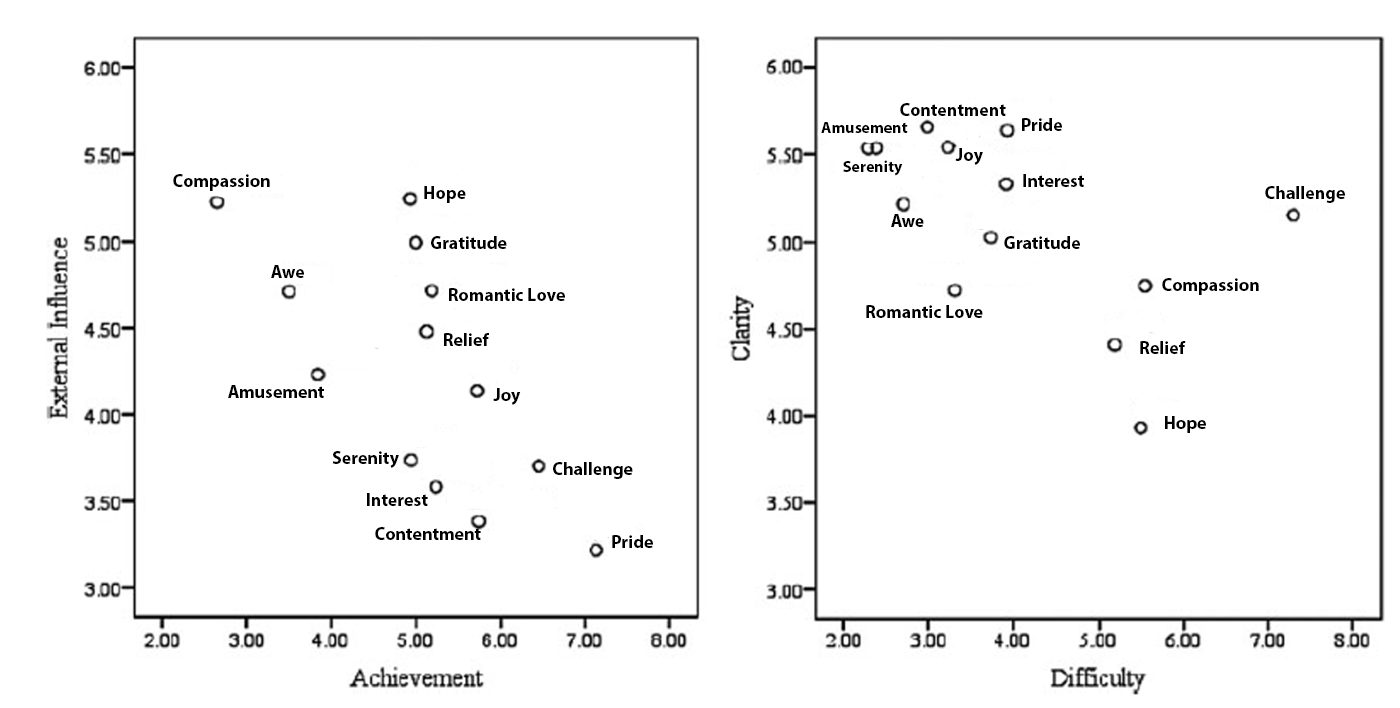
Reproduced from “Differentiation of 13 positive emotions by appraisals,” E.M.W. Tong, 2014, Cognition and Emotion, 29(3), p. 497 (https://doi.org/10.1080/02699931.2014.922056) Copyright 2014 by Taylor & Francis.
An earlier study (Smith & Ellsworth, 1985), similar to Tong, asked participants to recall 15 different positive and negative emotions. For each emotion, participants rated their cognitive appraisals. The six appraisal dimensions identified in this study are defined in Table 6.
Table 6
Cognitive Appraisal Dimension Definitions for Smith and Ellsworth (1985) Study
| Cognitive Appraisal Dimension | Definition |
|---|---|
| Pleasantness | Amount of pleasantness / unpleasantness felt |
| Anticipated Effort | Amount of mental or physical effort |
| Certainty | Clarity and understanding about the situation |
| Attentional Activity | Paying attention to and thinking about the cause of the emotion |
| Self-other Responsibility / Control | Whether self or other person was responsible for even that cause emotion |
| Situational-Human Control |
|
Adapted from “Patterns of cognitive appraisal in emotion” by C.A. Smith and P.C. Ellsworth, 1985, Journal of Personality and Social Psychology, 48(4), p. 822. Copyright 1985 by the American Psychological Association.
The three figures below show the location of positive and negative emotions for a combination of appraisal patterns. Based on these figures, please note a few take-home points:
- Figure 4 – Effort and Pleasantness: This study found that all positive emotions were rated as moderate to highly pleasant, including challenge. This is in contrast to Tong’s (2014) study that found challenge was more unpleasant than pleasant (Table 5 and Figure 3). Most negative emotions were rated as highly unpleasant and requiring high effort, whereas most positive emotions were rated as pleasant and requiring minimal effort.
- Figure 5 – Certainty and Attention: All positive emotions were rated as high in attention but varied in their uncertainty. For instance, hope was high attention-high uncertainty, whereas happiness, challenge, and pride were high attention-high certainty.
- Figure 6 – Situational/Human Control and Self/Other Control: The dimension situational control-human control is unrelated to perceptions of whether the self or other people caused the event. Except for interest, the positive emotions were perceived to be caused by the self. Contrast that with negative emotions – some of which were caused by others (e.g., anger and disgust) while some were caused by the self (e.g., shame and guilt). People perceived most positive emotions to be under human control but hope and interest were viewed as under situational control, but not really caused by the self or others.
Figure 4
Location of Positive and Negative Emotions along Effort and Pleasantness Cognitive Appraisals
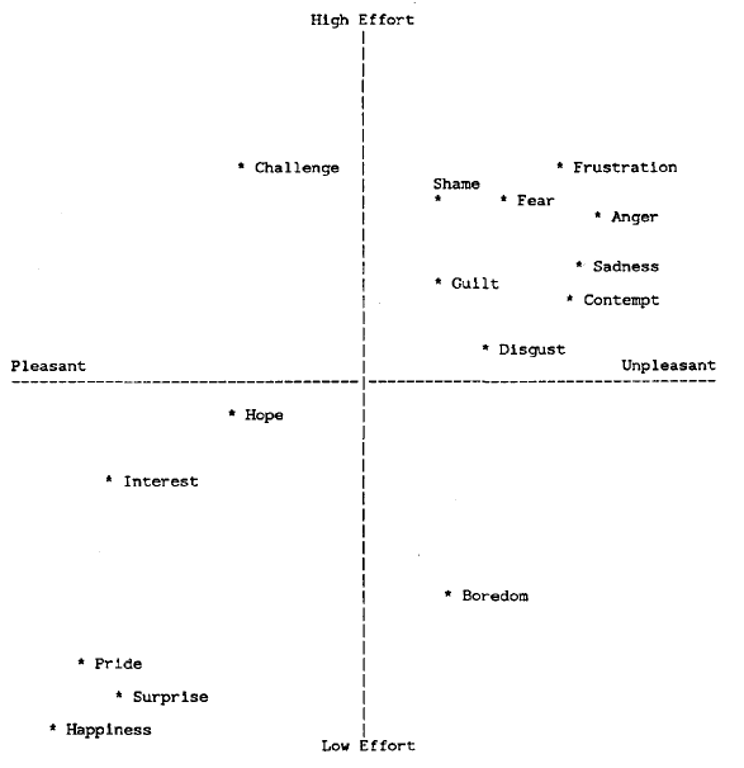
Figure 5
Location of Positive and Negative Emotions along Certainty and Attention Cognitive Appraisals
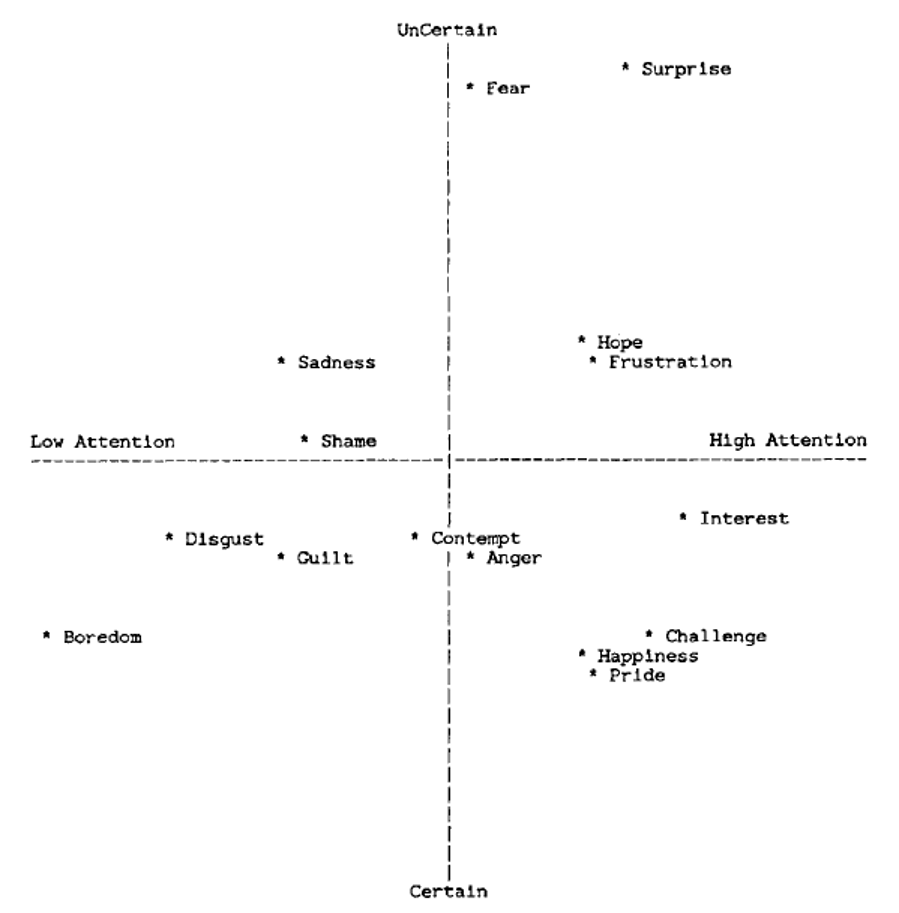
Figure 6
Location of Positive and Negative Emotions along Situation-Human Control and Perceptions of Control – Self Vs. Other
